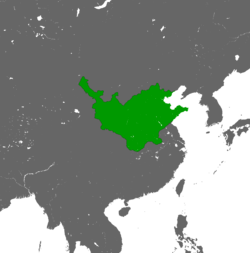| Great Shun大順 | |||||||||||
|---|---|---|---|---|---|---|---|---|---|---|---|
| 1644–1646 | |||||||||||
 The Shun dynasty at its peak in 1644 The Shun dynasty at its peak in 1644 | |||||||||||
| Status | Short-lived dynasty of China | ||||||||||
| Capital | Xi'an (1644) Beijing (1644 – 5 June 1644) | ||||||||||
| Common languages | Chinese | ||||||||||
| Religion | |||||||||||
| Government | Monarchy | ||||||||||
| Emperor | |||||||||||
| • 1644–1645 | Li Zicheng | ||||||||||
| • 1645–1646 | Li Zijing | ||||||||||
| • 1646 | Li Guo | ||||||||||
| Historical era | Transition from Ming to Qing | ||||||||||
| • Established in Xi'an | 8 February 1644 | ||||||||||
| • Captured Beijing/Death of the Chongzhen Emperor | April 1644 | ||||||||||
| • Proclamation as the Yongchang Emperor | 3 June 1644 | ||||||||||
| • Fall of Beijing | 5 June 1644 | ||||||||||
| • Surrender to the Southern Ming | 1646 | ||||||||||
| Currency | Chinese coin, Chinese cash | ||||||||||
| |||||||||||
| Today part of | China | ||||||||||
| Part of a series on the | ||||||||||||||||
| History of China | ||||||||||||||||
|---|---|---|---|---|---|---|---|---|---|---|---|---|---|---|---|---|
Prehistoric
|
||||||||||||||||
Ancient
|
||||||||||||||||
Imperial
|
||||||||||||||||
Modern
|
||||||||||||||||
| Related articles | ||||||||||||||||
| Ming−Qing transition | |
|---|---|
|
The Shun dynasty, officially the Great Shun, also known as Li Shun, was a short-lived dynasty of China that existed during the Ming–Qing transition. The dynasty was founded in Xi'an on 8 February 1644, the first day of the lunar year, by Li Zicheng, the leader of a large peasant rebellion, by proclaiming himself "emperor" (皇帝) instead of the title "king" (王) before founding the dynasty.
The capture of Beijing by the Shun forces in April 1644 marked the end of the Ming dynasty, but Li Zicheng failed to solidify his political and military control, and in late May 1644 he was defeated at the Battle of Shanhai Pass by the joint forces of Ming general Wu Sangui who defected to the Qing dynasty after the fall of the Ming dynasty, with Manchu prince Dorgon. When he fled back to Beijing in early June, Li finally proclaimed himself the Yongchang Emperor of the Great Shun and left the capital the next day after setting the palace ablaze and ransacking the government offices. He may have intended to resume his Imperial claims later on by proclaiming his accession in the Forbidden City. After the death of the emperor, Shun remnants joined with the Southern Ming in Nanjing, while continuing to refer to Li as their "deceased emperor". The Shun dynasty weakened dramatically after the death of Li Zicheng in 1645. The successors, his brother Li Zijing and nephew Li Guo, could not fight back and the dynasty ended in 1649 when Li Guo died in Nanning, Guangxi.
After the Shun was created, Li Zicheng ordered the soldiers to kill the Ming remnants still existing in Beijing, resulting in strong rebellions from the forces of the Southern Ming. With the Shun ministers constantly fighting for power, the dynasty effectively lasted less than a year.
Monarchs
| Personal name (birth–death) |
Period of reign | Era names and dates |
|---|---|---|
| Lǐ Zìchéng 李自成 (1606–1645) |
1644–1645 |
Yǒngchāng (永昌) 1644–1646 |
| Lǐ Zìjìng 李自敬 (?–1646) |
1645–1646 | |
| Lǐ Guò 李過 (?–1649) |
1646 |
Generals and ministers
- Niu Jinxing (牛金星), chancellor
- Gu Jun'en (顧君恩), staff
- Li Yan (李岩), staff
- Song Xiance (宋獻策), staff
- Liu Zongmin (劉宗敏), general
- Yuan Zongdi (袁宗第)
- Tian Jianxiu (田見秀)
- Hao Yaoqi (郝搖旗), general
- Li Guo (李過), general and nephew of Li Zicheng
- Li Zijing (李自敬), general and younger brother of Li Zicheng, inherited the throne after the death of Li Zicheng
- Gao Jie (高傑), general
- Lady Gao Guiying (高桂英), Li Zicheng's wife and general
See also
Notes
- simplified Chinese: 顺朝; traditional Chinese: 順朝; pinyin: Shùn cháo
- simplified Chinese: 大顺; traditional Chinese: 大順; pinyin: Dà Shùn
- simplified Chinese: 李顺; traditional Chinese: 李順; pinyin: Lǐ Shùn
References
- Frederic Wakeman Jr. (1985). The Great Enterprise: The Manchu Reconstruction of Imperial Order in Seventeenth-century China. University of California Press. p. 313. ISBN 978-0-520-04804-1.
- Huang Weiping (黃衛平) (2010). Draft history of Da Shun (大順史稿). Publishing House of San Qin (三秦出版社). pp. 194 to 197. ISBN 978-7-807-36899-1.
Further reading
- Wakeman Frederic (1981). "The Shun Interregnum of 1644", in Jonathan Spence, et al. eds. From Ming to Ch’ing: Conquest, Region, and Continuity in Seventeenth-Century China. Yale University Press.
- Huang Weiping (黃衛平) (2010). "Draft history of Da Shun (大順史稿)"
| Preceded byMing dynasty | Dynasties in Chinese history 1644 |
Succeeded byQing dynasty |